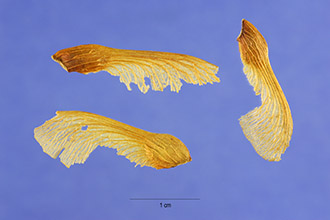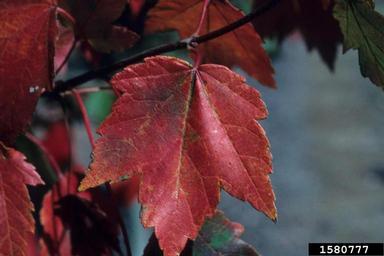Many trees that turn beautiful colors in the fall. That is a major factor in why so many people love the fall. It would be great to add some of those trees to our acreages and landscapes. The most common trees that we use for good fall color are the maples, which come in many different colors, including yellow to orange to red. A great maple for red color is red maple (Acer rubrum).
Red maple is a beautiful tree that grows up to around 50 feet tall. The leaves are divided 3 or 5 times and have the typical maple leaf appearance. Red maple leaves are a dark green on the top side of the leaf and are gray and slightly fuzzy on the bottom side. Small reddish flowers appear in dense clusters along the branches of the tree in the late winter to early spring, prior to emergence of the leaves. For seeds, maple trees produce samaras, often referred to as helicopters. The samaras on a red maple are red as they are first set on the tree and turn brown later in the summer.
There are many different varieties of red maple including 'Red Sunset' and 'Ruby Frost' which are used for their colors. 'Red Sunset' has a reliable orange-red fall color that many find very intriguing. 'Ruby Frost' has bronze-purple summer foliage and red fall color. The freemanii hybrids are most known for the variety 'Autumn Blaze,' because this is often planted for its amazing fall color.
Red maples can adapt to many different environments. The natural habitat of Acer rubrumcan range from low wetlands to moist forests to dry ridges, according to The National Wildlife Federation's Field Guide to Trees of North America. Many people choose this tree over others with good fall color because it has a medium to fast growth rate so it doesn't take as many years to fully mature. The red maple is used both as a shade tree and as a specimen tree to add interest to your landscape.
Red maple is great for many other uses, according to the United States Department of Agriculture Natural Resource Conservation Service. The sap from red maple can be used to make maple syrup, but it does not have as high of sugar content as its cousin, the sugar maple. The wood can be used to make furniture due to its white, fine-grained properties. It is used to for flooring, cabinets, musical instruments, tool handles, and much more. Native Americans used the bark for a wash for inflamed eyes or cataracts. They also used the inner bark to make a tea to heal cough and diarrhea. In addition, bees often visit red maples early in the spring for pollen.
Consider adding the red maple to your acreage or in your landscape. You can purchase it at most nurseries in the area because it is a good tree choice for our climate. Besides having great color to look forward to every autumn, it looks beautiful during the spring and summer months, too. A red maple will provide you with enjoyment for many years to come.


